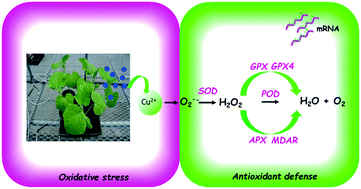当前位置:
X-MOL 学术
›
Environ. Sci.: Nano
›
论文详情
Our official English website, www.x-mol.net, welcomes your
feedback! (Note: you will need to create a separate account there.)
Activation of antioxidant and detoxification gene expression in cucumber plants exposed to a Cu(OH)2 nanopesticide
Environmental Science: Nano ( IF 5.8 ) Pub Date : 2017-06-28 00:00:00 , DOI: 10.1039/c7en00358g Lijuan Zhao 1, 2, 3, 4, 5 , Qirui Hu 3, 4, 6, 7 , Yuxiong Huang 1, 2, 3, 4, 5 , Aaron N. Fulton 2, 3, 8, 9 , Cameron Hannah-Bick 3, 4, 10 , Adeyemi S. Adeleye 1, 2, 3, 4, 5 , Arturo A. Keller 1, 2, 3, 4, 5
Environmental Science: Nano ( IF 5.8 ) Pub Date : 2017-06-28 00:00:00 , DOI: 10.1039/c7en00358g Lijuan Zhao 1, 2, 3, 4, 5 , Qirui Hu 3, 4, 6, 7 , Yuxiong Huang 1, 2, 3, 4, 5 , Aaron N. Fulton 2, 3, 8, 9 , Cameron Hannah-Bick 3, 4, 10 , Adeyemi S. Adeleye 1, 2, 3, 4, 5 , Arturo A. Keller 1, 2, 3, 4, 5
Affiliation

|
Cu-containing nanopesticides are increasingly being used as fungicides in modern agriculture. However, their fate, transport and toxicity in crop plants have been less studied. Here, we exposed 3 week-old cucumber plants cultivated in artificial media to different concentrations of a Cu(OH)2 nanopesticide (0, 2.5 and 25 mg) for 7 d. The physiological and molecular responses were investigated. In order to elucidate the contribution of copper ions to the response, we also exposed the plants to CuSO4. Results showed that the Cu(OH)2 nanopesticide did not reduce the photosynthetic pigment production. In contrast, 10 mg Cu ions induced a significant decrease in photosynthetic pigment levels (around 25%) and leaf chlorosis symptoms. Foliar exposure to 25 mg Cu(OH)2 nanopesticide induced significant changes in mRNA levels of antioxidant and detoxification-related genes; 6 genes (SOD, GPX4, GPX, MDAR, POD, WRKY6) were up-regulated up to 9-fold, and one (cAPX) was down-regulated by 32%. The Cu(OH)2 nanopesticide at both dose levels (2.5 and 25 mg per plant) decreased the transcript production of a stress-related gene (DNAJ) by 40% and 80%, respectively. The up-regulation of the transcript levels of SOD, GPX4, GPX, MDAR, POD, and WRKY6 and down-regulation of DNAJ was also observed in CuSO4 treated plants (with increases of up to 7-fold), indicating that most of the responses are due to released copper ions. We postulate that the increased mRNA levels of antioxidants and detoxification enzymes reflect plant adaptation to over-generated reactive oxygen species (ROS) triggered by copper ions. The activated genes could serve as potential biomarkers of nanopesticide exposure and may be applicable to other plant/Cu nanopesticide interactions.
中文翻译:

暴露于Cu(OH)2纳米农药的黄瓜植株中抗氧化剂和解毒基因表达的激活
含铜纳米农药越来越多地被用作现代农业中的杀菌剂。但是,对它们在农作物中的命运,运输和毒性的研究较少。在这里,我们将在人工培养基中种植的3周龄黄瓜植株暴露于不同浓度的Cu(OH)2纳米农药(0、2.5和25 mg)7天。生理和分子反应进行了调查。为了阐明铜离子对响应的贡献,我们还使植物暴露于CuSO 4。结果表明,Cu(OH)2纳米农药并没有减少光合色素的产生。相反,10 mg铜离子可导致光合色素水平显着降低(约25%)和叶片萎黄症状。叶面暴露于25 mg Cu(OH)2纳米农药会导致抗氧化剂和排毒相关基因的mRNA水平发生显着变化。SOD,GPX4,GPX,MDAR,POD,WRKY6 6个基因上调至9倍,而一个基因(cAPX)下调32%。两种剂量水平(每株植物2.5和25 mg )下的Cu(OH)2纳米农药均降低了胁迫相关基因(DNAJ)的转录产物分别减少40%和80%。的转录水平的上调SOD,GPX4,GPX,MDAR,POD和WRKY6和下调的DNAJ在硫酸铜中也观察到4处理的植物(最多的增大到7倍),表明大部分的响应是由于释放的铜离子引起的。我们推测抗氧化剂和排毒酶的mRNA水平升高反映了植物对铜离子触发的过高活性氧(ROS)的适应性。激活的基因可以作为纳米农药暴露的潜在生物标记,并且可以应用于其他植物/铜纳米农药的相互作用。
更新日期:2017-08-10
中文翻译:

暴露于Cu(OH)2纳米农药的黄瓜植株中抗氧化剂和解毒基因表达的激活
含铜纳米农药越来越多地被用作现代农业中的杀菌剂。但是,对它们在农作物中的命运,运输和毒性的研究较少。在这里,我们将在人工培养基中种植的3周龄黄瓜植株暴露于不同浓度的Cu(OH)2纳米农药(0、2.5和25 mg)7天。生理和分子反应进行了调查。为了阐明铜离子对响应的贡献,我们还使植物暴露于CuSO 4。结果表明,Cu(OH)2纳米农药并没有减少光合色素的产生。相反,10 mg铜离子可导致光合色素水平显着降低(约25%)和叶片萎黄症状。叶面暴露于25 mg Cu(OH)2纳米农药会导致抗氧化剂和排毒相关基因的mRNA水平发生显着变化。SOD,GPX4,GPX,MDAR,POD,WRKY6 6个基因上调至9倍,而一个基因(cAPX)下调32%。两种剂量水平(每株植物2.5和25 mg )下的Cu(OH)2纳米农药均降低了胁迫相关基因(DNAJ)的转录产物分别减少40%和80%。的转录水平的上调SOD,GPX4,GPX,MDAR,POD和WRKY6和下调的DNAJ在硫酸铜中也观察到4处理的植物(最多的增大到7倍),表明大部分的响应是由于释放的铜离子引起的。我们推测抗氧化剂和排毒酶的mRNA水平升高反映了植物对铜离子触发的过高活性氧(ROS)的适应性。激活的基因可以作为纳米农药暴露的潜在生物标记,并且可以应用于其他植物/铜纳米农药的相互作用。











































 京公网安备 11010802027423号
京公网安备 11010802027423号